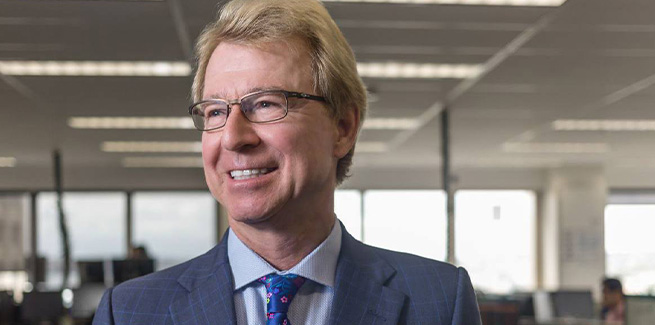AMP’s chief economist, Dr Shane Oliver, has flagged that Australian property prices may start to ease off as interest rates rise, bringing the “supercycle boom” that has taken hold this century to an end.
The comments come in a new segment on AMP’s Simplifying Investing podcast series, which draws on the knowledge of AMP’s staff to help Australians better understand and engage with their investments and finances.
The Oliver’s Insights segment involves Dr Oliver breaking down the key issues impacting the economy and investment markets, with the first episode unpacking the property market outlook, interest rates, geopolitical events, and election implications.
In the episode, Mr Oliver highlighted that property prices have increased, on average, by around 20 per cent while wages have only gone up 3.7 per cent over the past 18 months, and that fixed rates on home loans have almost doubled in the last 12 months, reducing the amount of money that people can borrow and causing deteriorating affordability for home buyers.
Forecasting that the Reserve Bank of Australia could raise rates to “about 1 per cent“ by the end of 2022 and “up to around 1.5 per cent next year” – and with a large segment of borrowers rolling off fixed rates – Dr Oliver outlined that these could act as a “dampener for new borrowers but also affect existing borrowers”.
“I don’t think that’s necessarily going to cause people to default, I think that’s unlikely. Or, if there is a bit of that [it would] be relatively minor and manageable,” he said.
“The bigger issue will be that, as rates go up, people can borrow less and therefore pay less for housing. On top of that, with high inflation and an increasing cost of living, it makes it harder to save for a deposit.”
Referencing the central bank’s estimates that the median borrowers are about two years ahead of their repayment schedule and have buffers in place, Dr Oliver said that the central bank will “proceed somewhat cautiously at raising rates” and “probably won’t have to raise interest rates as much as they did in the past to get a given slowing in demand because of given slowing in inflation”.
However, he went on to outline that house prices would likely start falling soon: “We’re seeing increasing supply in Sydney and Melbourne. We’re seeing a rotation back in consumer spending for services (so that may reduce housing demand at the margin), and we’re seeing a decline in home buyer confidence.
“So, [we see] all these things as the key drivers for a decline in house prices over the next 18 months, two years.”
While Mr Oliver said he didn’t expect prices to crash, he suggested that property prices could fall by between 10 and 15 per cent (or even as high as 25 per cent) as borrowers adjust to a new interest rate environment.
He told the podcast: “We don’t know how people are going to respond to rising interest rates. The last time we saw a rise in official interest rates was way back in 2010. So, many borrowers have simply never seen a period of rising interest rates... So that’s going to create a bit of stress.
“And also, there’s risks that – like we’re seeing in the US at present – inflation surprises on the upside and the RBA might end up having to tighten a lot more than initially thought.
“What will be the impact of slowing property prices on the economy? We saw in 2017-2019 when prices around the country fell 10 per cent... that slowed the economy down. If that occurs this time around (and it probably will, because you get this negative wealth effect; your wealth goes down, you feel poorer, you spend less) then it’s going to take pressure off the Reserve Bank in terms of how much they have to raise interest rates.”
The AMP chief economist flagged that the bigger question he was mulling over was whether Australia is now “near the end of the long term boom in property prices that we’ve seen over the last 25 years?”
He suggested that as many borrowers had circumnavigated lower wage growth by taking up more debt, a rising interest rate environment would mean that people would not be able to progressively borrow more, which would dampen demand and therefore price growth.
However, Dr Oliver outlined that falling house prices would help improve the issue of housing affordability in Australia.
“It’s quite possible we’ve seen a low point in interest rates and – if inflation picks up more sustainably going forward (and there’s good reasons to suspect that it will) – then we might actually see a rising trend in interest rates which will remove the tailwind and the ever-increasing amount that people can borrow to pay for houses,” he added.
“There’s a good argument there that we may have seen we’re maybe coming in at the end point of the supercycle boom in property prices that we’ve set over the last 25 years…
“I think there’s a good chance that the next 10 years will see lower property price gains than over the last 10 years and some affordability stressors may start to abate a little bit, I hope.”
Looking at more permanent solutions for housing affordability, Dr Olive suggested that the following steps could improve the chances of buyers being able to afford property:
- A commitment from all levels of government to boost supply
- Ensuring that immigration levels match the ability of property markets to supply new property
- Encouraging decentralisation and building on the working from home
- Replacing stamp duty with land tax and reducing, if not eliminating, the capital gains tax discount
[Related: Property industry braces for rate rises]
